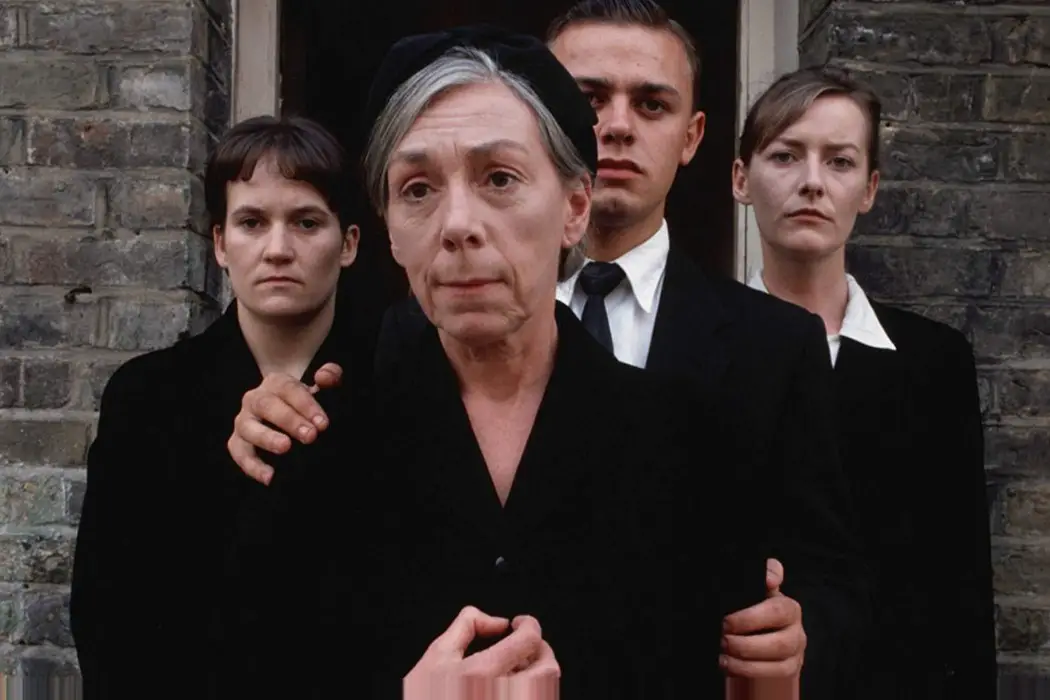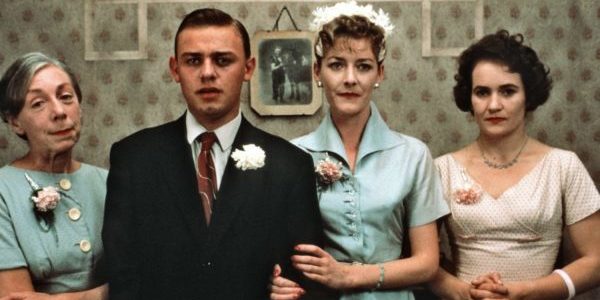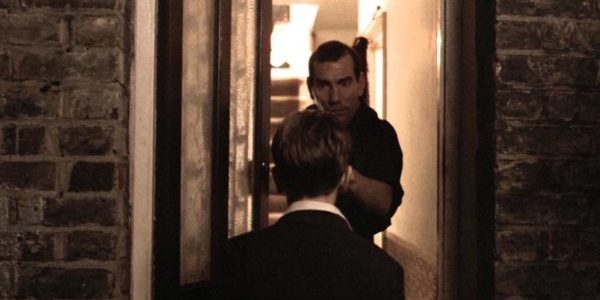DISTANT VOICES, STILL LIVES: An Extraordinary Debut Released On Its 30th Anniversary

Midwesterner, movie lover, cinnamon enthusiast.
British filmmaker Terence Davies is an auteurist’s dream. Perhaps more than any other filmmaker, discussions of his work are supported by a series of rote biographical details: the youngest of ten children (seven surviving), a close relationship with his mother, a tumultuous one with his father and own homosexuality (he says he’s celibate because he doesn’t like the gay scene), his loss of faith and love of moviegoing.
Quite simply, this is because, as Joanna Di Mattia puts it, Davies “makes films to come to terms with himself,” and therefore is often the subject of his own work. But even when there is no Davies avatar, as with The Deep Blue Sea and A Quiet Passion, Di Mattia posits that our understanding of his protagonists “is amplified by what we know Davies sees of his own story in theirs.”
Distant Voices, Still Lives, his 1988 film about a Liverpool family of five during the ‘40s and ‘50s, falls oddly between these two poles; it’s distinctly autobiographical, yet Davies is not the subject, as he so clearly is in The Long Day Closes and Of Time And The City. Because the film is propelled solely by memories of his own family, and because he doesn’t include himself as a character, the film is oddly imbued by Davies’ presence as an omniscient observer; he’s there though you never see him.

Arrow Academy’s new release of Distant Voices, Still Lives, just in time for its 30th anniversary, won’t do anything to slacken viewers’ understanding of Davies’ work through the prism of his biography as the director has generously dedicated his time to the film’s 4K restoration, its touring and a feature-length commentary.
Besides for the sake of posterity, I particularly welcome a home video release of Davies’ debut — especially one as thorough and prestigious as Arrow’s — because of its elliptical, serpentine narrative structure. Being a flip book of memories that bounces in time to and fro, viewers are dropped in on small moments, many of which are destined to pass by on first watch but linger on second and third. Like the miniscule scene of one sister telling the other that her beau bought her Chanel No. 5, with the bottle glowing on the table in front of them. We don’t have context for this scene, and we don’t need it to appreciate that it represents the passing sweetness in between the near-constant trauma their father bestows upon the family. Distant Voices, Still Lives doesn’t play to our acclimated sense of structure, but churns according to its own logic, which is often a series of juxtapositions, not linear character development.
The Logic of Instinct
In 1989, for the Chicago Reader, Jonathan Rosenbaum started his review with a collection of attempts to define the film, before writing the following:
“The problem with all these descriptions of Distant Voices, Still Lives is that though each is partially accurate, they only dance around the periphery of what is a primal experience; that they represent the shards of my attempts to describe the essence of a masterpiece that reinvents filmgoing itself. I saw it twice at the Toronto film festival last September, and twice again earlier this month, and the inadequacy of my efforts is largely due to the fact that great films have a way of imposing their own laws and definitions that ordinary descriptions can’t reach.”
The film’s laws are better described as Davies’ instinct. On the disc’s commentary, the filmmaker says, during the gorgeous and strange opening shot of the front hallway of a Liverpool home — shipping forecast and family voices overheard — before making a 180-degree turn to the door, that he had no idea what he was doing, operating entirely of his own logic, and that today, he would never be so brave to start a film with such a composition — one that’s quite similar to the one that opens his following film, The Long Day Closes.
Rosenbaum’s claim that Davies reinvents filmgoing, to an extent, is not hyperbole. It feels as if Davies has no consideration, or even knowledge, of fictional filmmaking rules (any viewer of his memoir documentary Of Time And The City knows, to the contrary, that he went to the cinema “with a frequency that would shame a sinner”), and is rather ruled by his intense emotion and tableau of memories. Rosenbaum continues:
“We all know that ‘real time’ and ‘film time’ aren’t the same thing, but the emotional time of recollection that this film works with is so singular that it doesn’t seem to bear much relation to what we ordinarily mean by either of these temporal registers. The film as a whole lasts only 85 minutes, but the density that it conveys is closer to that of a three-hour epic.”

During one of the two included interviews between Geoff Andrew and Davies (a decade apart from each other) the film historian says the film is a series of associations for Davies, which is about as succinct a way to grasp the film. The audio of the shipping forecast that we open on, which Davies mentions being so fond of, is a memory that he draws an entire era out of. He talks about the forecast (and other tangible items) as a key that unlocks a wide set of associative elements, and this psychological transaction is perhaps the best way to define Distant Voices, Still Lives. Although this and The Long Day Closes invoke, for me, other auteurs’ great “nostalgia” works of the ‘80s, such as Ingmar Bergman’s Fanny & Alexander or Woody Allen’s Radio Days, Davies’ early works are unparalleled in their construction.
A Gestural Recollection
In one of four included essays, Christina Newland, while questioning the film’s relative location to British social realism, says the film is only interested in the textures of its historical placement rather than its actual structures, “It’s an utterly unconventional approach to what should be fairly run-of-the-mill material on paper: a family’s ups and downs after the death of their often-cruel father. Filmic realism is of no concern, exchanged for a rare lyricism in application to the subject matter.”
Just as we don’t know the context of the Chanel No. 5 moment, we rarely know the extent of why a traumatic situation is so sad, like when the father refuses his son’s entry into the home, which Davies explains actually happened to one of his brothers — he was never allowed back into their home. But he spares us this context because these stories aren’t important to what Distant Voices, Still Lives is, which is a gestural recollection of pregnant moments.
And because the film itself acts as a series of Davies’ personal memories, his commentary track is, more often than not, a series of him reliving them, expounding on the real-life situations that have no bearing on the film itself but are a joy to listen to. If you’re someone who’s afraid a commentary track like this will strip your enjoyment of the film’s abstractness, you may want to stay away, although Davies also offers a handful of lovely anecdotes on film construction and theory inspired by some of Distant Voices, Still Lives’ more metaphysical moments.

And then there are moments where his own memory aids the film’s textual reading, like during the scene of the father (played by Pete Postlethwaite) laying Christmas stockings on the end of the children’s bed in the middle of the night. He pauses and exhibits an unprecedented display of affection to the sleeping children. It’s a scene I felt very touched by, but as Davies’ correctly mentions on the commentary track, though many critics found the moment sympathetic, he finds no sympathy for a character that only shows his children love when they’re asleep, unable to see or feel it.
Many times throughout the disc’s supplements, when recounting life with his father, whom he calls psychotic, Davies said he had to temper the fictional patriarch’s actual actions, because, if he would’ve written him true to life, viewers simply wouldn’t believe it. You can hear the filmmaker recount many of such harrowing instances during the featured interviews and commentary, but what this comment says, in a larger sense, is that Davies understood the medium on a very primal level. He knew how to poetically transpose real life onto cinema in a way that made sense, rather than fitting cinema to his own life story, as too many autobiographical films tend to do.
Distant Voices, Still Lives Conclusion
Rosenbaum ended his 1989 review saying, “I have every reason to believe that years from now when practically all the other new movies currently playing are long forgotten, it will be remembered and treasured as one of the greatest of all English films.” He wasn’t wrong. As Mark Kermode mentions in the disc’s introduction, Distant Voices, Still Lives landed third on Time Out’s 2011 list of the best British films of all time (behind Don’t Look Now and The Third Man). Thankfully, Arrow has done the film justice, both in presentation and the bounty of supplements.
During the Q&A with Geoff Andrew at the BFI Southbank, Davies says he was interested in Emily Dickinson as a biopic subject for A Quiet Passion because her genius wasn’t recognized during her time, with only a few of nearly 1,800 poems published before her death. Between Arrow’s release of Distant Voices, Still Lives and Criterion’s 2014 release of The Long Day Closes, Davies is getting the recognition he deserves, and during his lifetime.
Distant Voices, Still Lives was released on Blu-Ray from Arrow Academy on Oct. 23.
Does content like this matter to you?
Become a Member and support film journalism. Unlock access to all of Film Inquiry`s great articles. Join a community of like-minded readers who are passionate about cinema - get access to our private members Network, give back to independent filmmakers, and more.












